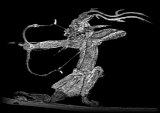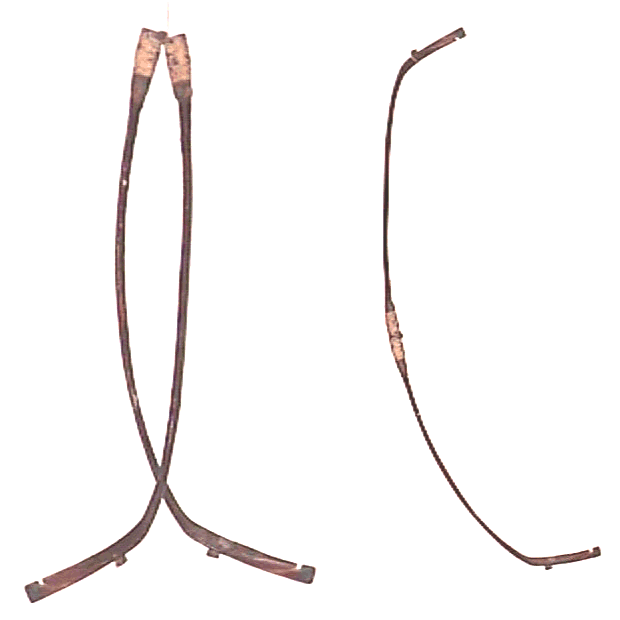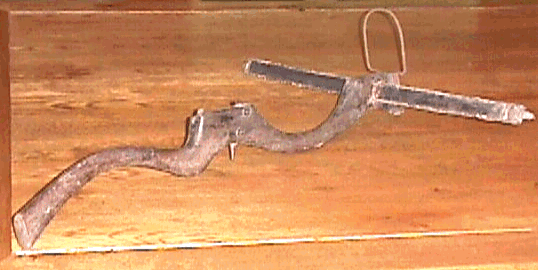

A Letter from Peking
Dear Friends,
A recent business visit to Peking has left me sufficient time to follow up my Chinese traditional archery studies for a few hours and a very interesting few hours they were, too.
Sunday morning I got up early and went of to the open-air junk market at Pan Jia Yuan, near the Temple of Heaven. I had hoped to find some bows on sale - perhaps from the national minority areas. However, apart from a very miserable specimen which had been artfully decorated with what seemed to be a purple satin table cloth, nothing.
But the visit was not in vain. One stall-holder had a number of bronze arrowheads from the Han Dynasty, including some with a leaf-shape which I had not found before. At the next stall I came across a bronze whistling arrowhead, used for signalling to troops during battle. Such arrowheads are usually plain ovals like a small American football on a stick, about two inches long and pierced with four holes. On the tang of some of these arrowheads are forward-pointing spikes to which oily cloth strips were attached. The cloth strips could then be lit so that apart from a sound, the arrow would also leave a smoke trail as a signal to the troops.
As I was haggling in Chinese, a man came over and said "Ah! You're interested in arrowheads, too!". He introduced himself as 'Arrowhead Wang', an avid collector and researcher on Chinese arrowheads. After a short chat, it was clear he was a real font of knowledge on Chinese arrowheads, and very keen to share his knowledge with fellow-enthusiasts.
But more interesting still, he claimed to know a retired man who was a Chinese traditional bow-maker. Now that would be a find, because to my knowledge, Chinese bows have not been managed in the traditional way since the 1950s.
We decided to exchange telephone calls in a couple of days so that I could visit him at home. He also promised to see whether the bow-maker would welcome a visit. At that point, we parted company.
Next I visited the 'Antique City' next to the Pan Jia Yuan market. There I found two old bows from about 1920 for sale. Both were in poor condition, but the prices were very low at about US$60 each. I bought them both. Why? Well, I shall let you into my secret fishing tip for buying bows in China.
I buy bows in China like other people go fishing. No amount of asking ever reaches the people who might have interesting old bows for sale. But if you go around a junk market wearing an old Chinese bow in poor condition over your shoulder, everyone knows what you are interested in, and they come running after you with offers. So I usually start my day buying a very damaged old bow to 'bait my line'.
 |
As it was, I ended Sunday with five interesting bows from different markets in Peking. Two were standard target bows in damaged condition: but one had a highly-decorated handle section well-preserved, and the other had some good decoration preserved on the limbs and a well-preserved maker's mark on the tip. More significantly, I obtained a very heavy strength bow (for testing drawing strength in military examinations: not for shooting arrows.) The bow was as tall as me (five foot ten) from tip-to-tip and strung with ox gut. It had remained strung because no-one had any idea how to flex it sufficiently to remove the string. I would estimate that when new, the bow would have drawn at about 200 pounds. Over time, it has probably come down to about 110 pounds. The string has stretched by about two inches, bringing the original depth of the string off the grip off by about the same amount. |
| Another interesting purchase was a Chinese take-down bow from the Qing Dynasty. The bow folds in two with an iron hinge at the back of the grip. (See 'Traditional Bowyers' Bible' Vol. II p. 125). The low draw-weight and small sayahs indicate that the bow was intended to be a stone-bow, not an arrow bow. The string (not present in the one I bought) would be double, parallel like tram-lines with a small basket opposite the grip to take the stone. Decoration on this bow was generally well-preserved (despite a liberal application of purple, water-based paint!) , and the string-bridges are present. |  |
The prices of old bows have fallen in Peking recently. This is because they are mostly bought by tourists as decorative items and there is now a steady supply of fakes which can be string up (but cannot be fired.) Demand for the originals, which are mostly in bad shape and cannot be strung or fired, has fallen.
Two days later, I had an afternoon free and I telephoned 'Arrowhead Wang'. He readily proposed to meet up. We made a rendezvous after lunch and then walked over to his home in a six-storey workers' block built in the 1960s. Although shabby on the outside, his home, shared with his wife and daughter, was neat and cosy. He had a little study where he sat me down with a mug of tea to look at his arrowhead collection.
He has particularly concentrated on whistling arrows and his collection contains materials from the Han Dynasty on in horn, bone, bronze and iron. His earliest were from the Hun/Ordos culture of northwest China dating from about 500 BC. He believes that in our part of the world, the whistling arrow was introduced by the Huns. He showed me some Chinese historical sources referring to the use of whistling arrows in Hun and Chinese military tactics.
One of his tasks has been to collect materials from archaeological journals which allow different arrowhead designs to be cross-referenced to different, documented archaeological excavations so that they can be approximately dated. He has lent me his notebook of clippings so that I can reproduce and translate them for ATARN.
One interest that 'Arrowhead Wang' has developed is in stone-bows. He has a number of stone-bow pellets and wrote an article about them for the 'Peking Evening News' ('Beijing Wanbao', 2 August 1998, page 2.) Again, 'Arrowhead Wang' readily donated the article to be translated into English and published by ATARN.
You will be glad to know that 'Arrowhead Wang' has agreed to become an ATARN corespondent.
Next ,we took a taxi over to the old 'Bow and Arrow Makers' Quarter', where dilapidated artisans' cottages still nestle along a winding back-street. Here we met Li Bo-cheng.
Li Bo-cheng is the fifth generation of a family of bow-makers. Born in 1944, he worked with his father making traditional Chinese bows for fifteen years until the business was closed down by the Red Guards during the Cultural Revolution which started in 1966. After that, he worked in a factory until his retirement.
He has not made any bows since before the Cultural Revolution, but remembers the techniques well, and has managed to preserve some of his old tools. His father passed away last year at the age of 82. The family business used to make bows under the mark 'Li Ji'. I have one of them.
We didn't have much time to discuss bow-making, but he showed me a magnificently-preserved stone-bow made by his father. Chinese stone-bows differ from arrow-bows in having short sayahs and a low-draw-weight (about 35 pounds at 28 inches.) They are not designed to be drawn so far as arrow-bows: only as far as the cheek. The string is made up of two parallel hemp cords which connect towards the tip with stiff, wooden straps. There are no string-bridges. At the centre of the double string is a small woven basket which can take the pellet. The limbs of the bow are covered in green snakeskin, and the bow had a traditional, shark skin grip.
Such bows were mainly used to catch pigeons. They were not intended to deliver a lethal blow: only to disable a bird so that it could be reared and bred. To that end, the pellets were light, hollow metal or clay balls about one inch in diameter. During the Nationalist Period (1911 - 1949) there were a number of people around the Bow-makers' Alley who could shoot these bows very accurately.

Bow-makers also made stone-bow crossbows on similar lines which were sold to children as toys. I have two such bows. Li Bo-cheng has a hand-copied, tenth-generation instruction manual on stone-bow technique. He may consider allowing it to be translated and published by ATARN in the future.
We had a long discussion about reviving the Chinese bowyers' art. Economically, it would be very difficult. There is no market in China for such bows. No doubt, in the West there are those who would drool at the mouth at the prospect of having a Chinese bow made by a traditional craftsman. But it takes three years to complete a single bow (of course many can be made simultaneously) and each should ideally be 'made-to-measure'.
Furthermore, the inherent weight of the materials used means that traditional Chinese bows will not operate at low draw-weights. Customers for anything below sixty pounds would be wasting their time.
We feel that one way to go forward is to create kits in which all the parts most difficult to build by hand would be manufactured by Chinese craftsmen. We would then supply all the parts - cut but not finished - together with a supply of prepared sinew and dried fish glue. The purchaser would apply the sinew to the draw-weight he needed. We would also supply string-bridges and birch bark for the decoration. Even with all this, the bow would tax all but the experienced bowyer.
If you have time, let me know if you think this scheme would work.
Yours ever,
Stephen
12 October, 1998